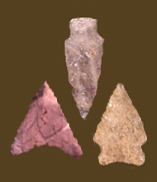
|
ROSSVILLE Defining Attributes Chronology The Rossville point is placed variously in the Early and Middle Woodland periods. At the Delaware Park site in Delaware, radiocarbon dates ranging from 2680 to 1310 BP (approximately 825 BC-675 AD in calendar years) were reported from features with Rossville points (Custer 1989). In the Northeast, one of the oldest radiocarbon dates associated with the Rossville is 2470 BP (somewhere between 750 and 550 BC in calendar years), while the youngest is 2050 BP (roughly 50 BC in calendar years) (Kinsey 1972). At the Accokeek Creek site, Rossville points were predominantly associated with Popes Creek pottery, thought to date between 500 BC and 300 AD (Stephenson and Ferguson 1963). At the Herring Island site in Cecil County, the Rossville was found with Mockley pottery, generally dated between 0 and 900 AD (Ward 1984). At the Abbott Farm site in New Jersey there are suggestions that the Rossville could continue into the Late Woodland period (Wall et al. 1996), while Ritchie (1971) and Stephenson and Ferguson (1963) speculate that its beginnings could be in the Terminal Archaic. Part of the reason for the wide range of dates proposed by various researchers for the Rossville could be its morphological similarity to the Piscataway and other teardrop types. Points with the general lozenge or teardrop shape of the Rossville and Piscataway may have been used from the Late Archaic through the Early and Middle Woodland, and perhaps even later. Description Blade: The blade edges are commonly excurvate, but can be straight. The cross section is lenticular to biconvex, with a high medial ridge sometimes present on one face. The shoulders range from non-existent to 25-30% wider than the stem, and are most often rounded. Haft Element: The stem is contracting, and has straight or convex edges. The base is commonly rounded, but can be pointed. Light basal grinding occasionally occurs. Size: Length ranges from 24 to 61 mm, with an average of 40 to 50 mm. Width ranges from 14 to 30 mm, with an average of 21 mm. Thickness ranges from 6 to 11 mm, with an average of 7 mm. (Interestingly, the published type descriptions largely agree on the actual dimensions of the Rossville, but differ in calling it “thick or “thin”). Technique of manufacture: Well-made by pressure flaking on all surfaces. Material: In a sample of 171 Rossville points from the lower Patuxent drainage, Steponaitis (1980) reported that 46% were quartzite, followed by quartz (41%), rhyolite (11%), and chert and jasper (1% each). In the area surrounding Zekiah Swamp on the lower Potomac, Wanser (1982) found that 55% of 72 Rossville points were quartz, with 31% quartzite, 13% rhyolite, and 1% chert. At the Accokeek Creek site in Prince George’s County, a majority of the 29 examples were quartzite, with 30% quartz and a few chert or other materials (Stephenson and Ferguson 1963). In the Monocacy River drainage, 65% of 48 Rossville points were rhyolite, with 24% quartz, 7% quartzite, and 5% chert (Kavanagh 1982). In the middle Potomac Valley, rhyolite Rossville points are most common, but quartz and quartzite are sometimes used (Hranicky 2002). Discussion The Rossville tends to be wider than the similar Piscataway point, with a more pronounced stem and shoulder, but there is morphological overlap (McNett and Gardner 1975). Also, Piscataway points are predominately made from quartz in much of Maryland, while Rossvilles utilize a more diverse range of materials. The relationship between the two types needs to be explored; it is possible that they represent morphological variations within a single type, or that generalized teardrop/lozenge-shaped points appeared and disappeared at various times in the Late Archaic and Woodland periods. Defined in Literature This type was originally noted in the early 20th century, but was first named and formally described by Ritchie (1961, revised 1971). Stephenson and Ferguson (1963) expanded the definition based on points recovered from the Accokeek Creek site in Prince George’s County. References |
![]()
Search by Shape:
(See Projectile Point Typology) |

|
Thank you for visiting our website. If you have any
questions, comments, Copyright © 2002 by |

|

